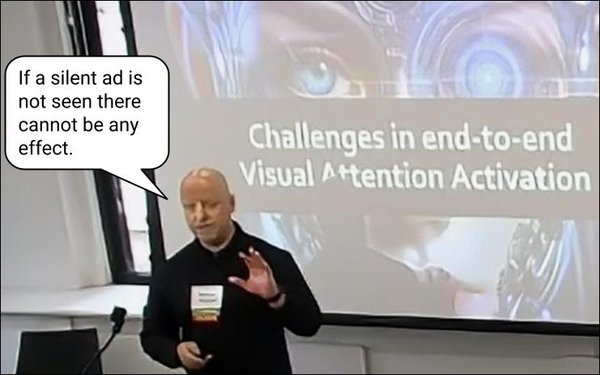
The Advertising Research Foundation (ARF) kicked off
a day-long attention workshop Tuesday by releasing the second phase of an “Attention Measurement Validation Initiative” analyzing 12 different research company approaches to measuring
attention.
The analysis studied the impact of 60 ad creative executions utilizing a wide variety of measurement approaches, which the ARF found to be equivalent to neither their
accuracy nor their inaccuracy, especially when compared to the way the respective advertisers ranked the success of their ads.
The definitions of attention used – whether
active or passive – were judged by the ARF Chief Research Officer Paul Donato and Director of Research Programs Tracy Adams to be driven by each of the measurement techniques being used,
including which reflected cognition, emotion, persuasion, memory and even sales predictability and combinations thereof.
advertisement
advertisement
So, what are the signposts from this tough but
balanced and fair test of approaches?
The measurement methods and techniques used in this ARF comparative analysis are vastly different and need to be closely assessed
and understood. One suggestion was that perhaps a hybrid of approaches would produce the best results.
The twelve different approaches exhibited consistent
“signatures” for the creative executions assessed nad found all the vendors to be generally congruent.
As such, attention metrics clearly provide a critical
“gateway” to understanding that ad effectiveness – intertwined with other measures of marketing pressures – optimize brand outcomes. However, how attention directly
relates to “outcomes” appears to remain an open question.
“If a silent ad is not seen there cannot be any effect,” Viomba CEO Markku
Mantymaa said, underlying the importance of understanding attention as measured by the complexities sensory perception signals.
Two cornerstones to an ad being
“seen,” he said are “eye fixations (with a minimum of 200-300 milliseconds) and “sacccades” (eye movements between fixations).
Attention
measurement is not only complex, but can clearly be expensive although Viomba is using AI efficiencies for predictive attention analytics.
I believe Mantymaa heard my
applause when he stressed that “viewable impressions,”-- which are often used as a proxy for “technically viewable” impressions – have no correlation to
attention.
This helped to set the stage for a panel entitled, “Are We Ready for Attention Standards?” The subplot: “Are we ready for attention as
a media currency?”
The panel was mixed on both questions. Interactive Advertising Bureau Vice President-Measurement Angela Eng seemed wary of attention as a
currency but liked the concept of establishing data elements of attention that can be defined and standardized. However, she appeared to be oriented to device signal reports, perhaps to maintain
the edge that “viewable impressions” gives social media via phones or desktops notably vs. long-form TV on big screens?
Media Rating Council Executive
Director and CEO George Ivie embraced the establishment of standards, underlining the care and attention needed to outline meaningful and valuable proxies or direct measures of attention.
Referencing Media Science CEO Duane Varan, he suggested measuring inattention may be the best place to start. He also stressed the importance of bringing the measurement of people
into the research equation, which was particularly refreshing, and I believe long overdue.
Offering an agency’s perspective, OMD Managing Director of Marketing
Science Burak Kurtun emphasized the value of attention to improve the impact of media and ad effectiveness by modifying target audience “reach & frequency” with attention
metrics. Like many of us, he ultimately does see attention as a currency – albeit integrated with other data – due especially to the influence of attention as driven by media
content.
Attention measures related to media evaluation will be the focus of Phase III of the ARF’s attention measurement initiative.
However, a major takeaway was surely that “viewable impressions,” which have no measurement of people whatsoever, will be finally dead as a media currency in the very near
future.
I would suggest that that cannot happen soon enough.